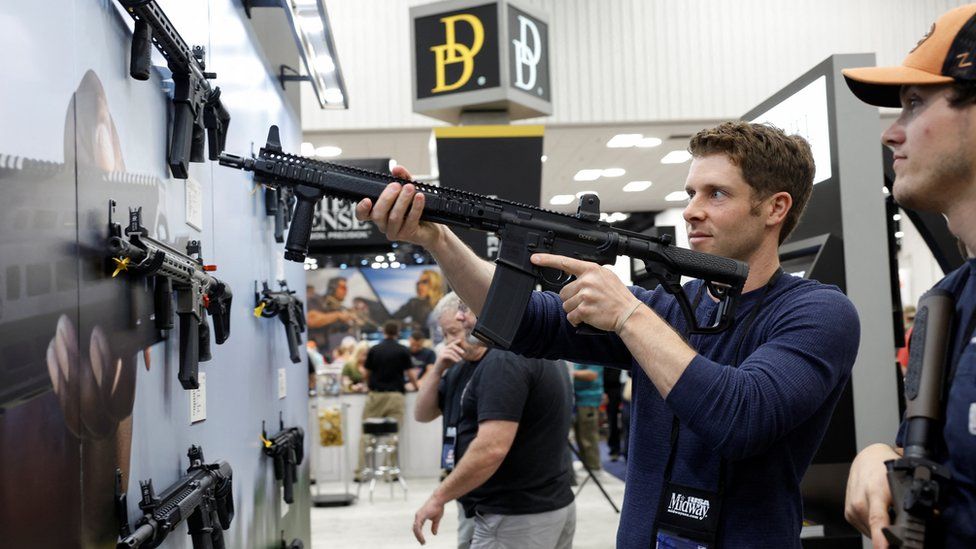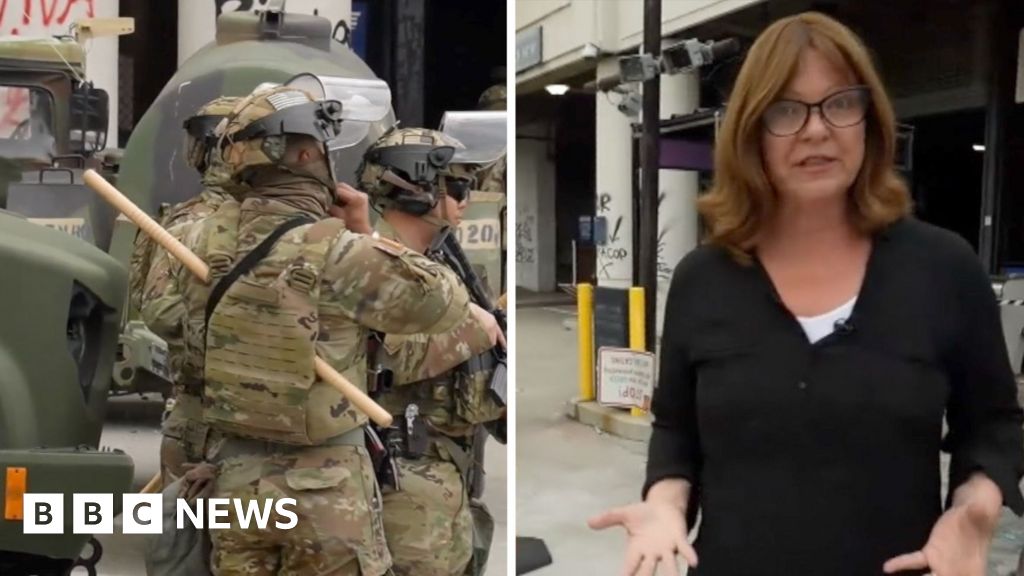ARTICLE AD BOX
 Image source, Reuters
Image source, Reuters
A NRA member poses with an AR-15-style weapon at the annual conference in Indianapolis, Indiana
By Chelsea Bailey
BBC News, Washington
The National Rifle Association (NRA)'s annual meeting this weekend will follow two back-to-back mass shootings.
The attacks in Nashville and Louisville, Kentucky - which together killed 11 people in just two weeks - have re-ignited nationwide protests and demands to ban military-style rifles.
But in the NRA's 14-acre exhibit hall, business is booming. There are hundreds of booths dedicated to customising the same gun that's become the mass shooter's calling card: The AR-15.
Affordable, customisable, lightweight and lethal, the AR-15-style rifle has become a lightning rod in America's bitter culture war over guns. As courts debate the constitution's Second Amendment, which guaranteed the right to bear arms, and consider whether to expand or restrict gun rights, the rise of the AR-15 is a flashpoint for both sides.
But the country didn't arrive at this moment by chance, experts and gun-industry insiders say. Here's how millions of Americans came to embrace the AR-15.
'I'm a gun enthusiast'
Colion Noir, one of the most prominent black commentators for the NRA, said that the first time he fired a gun, he was terrified. But by the second shot, he'd fallen in love with the power he felt "containing an explosion" in the palm of his hand.
"I'm a gun enthusiast," he said. "I'm what I've termed an ammo-sexual."
Image source, Colion Noir
Image caption,American gun rights advocate Colion Noir poses with an AR-15
Like millions of Americans, Mr Noir first began shooting handguns. But over time he found himself gravitating toward a new weapon of choice: The AR-15.
"If you think about buying a new car, for some reason, you keep seeing that car everywhere," he said of his growing love for guns. "That's kind of what happened."
And perhaps that's because the AR-15, and similar rifles, are indeed everywhere in the United States. By some industry estimates, there are more than 20 million AR-15-style rifles legally owned in the US today.
The rifle has become one of the most recognisable guns in America. Its silhouette is plastered on coffee, hats, flags and bumper stickers. Some US lawmakers proudly wear its likeness pinned over their hearts; others have proposed a bill to officially make the rifle America's "national gun."
But the AR-15's rise in popularity is also inexorably linked to a rise in mass shootings in the United States. The media has dubbed the rifle the "mass shooter's weapon of choice" and the AR-15, or a similar gun, has been used in at least 100 shootings where four or more victims were injured or killed in the last decade, according to data provided by the Gun Violence Archive.
Although research shows handguns are involved in the majority of gun deaths in the United States, AR-15-style rifles were used in the mass shootings at Sandy Hook, Parkland, Las Vegas, Sutherland Springs, Pulse Nightclub, Uvalde, the Covenant School in Nashville - and this week, the Old National Bank in Louisville.
None of this is lost on Mr Noir, who said he understands why some Americans have come to fear the rifle. But, he said, the semi-automatic firepower that makes anti-gun protesters recoil is the same thing that attracts a loyal following among AR-15 owners.
"I totally understand why some people can feel a certain negativity towards an AR-15," he said. "But the Founding Fathers utilised their rifles to defend this country. In that sense, I think it was inevitable that the AR-15 would become 'America's rifle.'"
A shift in gun culture
It wasn't long ago that the idea of millions of civilians owning a military-style rifle was unthinkable even to industry insiders.
Ryan Busse was a top executive at a firearms company in the early 2000s. Back then, he said, AR-15s and other "tactical" military-style weapons were banished to the back halls of industry shows and only accessible to law enforcement and former military members.
"The rest of the industry wouldn't let those things be displayed in the main, tasteful and respectable part of the show," he said.
Image source, Liaison Agency/Getty Images
Image caption,A school bus drives past an billboard for the NRA's annual meeting in 1999, after the Columbine shooting
Between 1994-2004, a federal law banned the manufacture, transfer and possession of military-style weapons for civilian use. While US President Joe Biden has pointed to that legislation - which passed when he was a senator - as one of the reasons the US used to have fewer mass shootings, it did not entirely limit ownership of the weapons.
Guns that were already owned weren't affected, and some forms of semi-automatic rifles were still allowed on the market.
Rather than any one law, Mr Busse said that the industry's decision to eschew tactical weapons was because there was a "social stigma" around them and leaders agreed that firearms should belong in the hands of the military and trained police officers.
"I've never owned one. To me, the guns have a very clear purpose. They are tactical weapons of war, and I wasn't planning on embarking on a planned military offensive action," he said.
But over time, that stigma began to shift, and a new era was ushered in with the War on Terror.
"I think the really critical event that defines gun culture today, although people don't recognise it, is actually 9/11," said AJ Somerset, a former Canadian soldier and journalist who spent much of his career documenting the firearms industry.
Image source, EPA-EFE/REX/Shutterstock
Image caption,In 2003, US soldiers patrolled Baghdad armed with M-16 rifles, the military's version of the AR-15
Back home, Americans who tuned in to the nightly news watched as soldiers wielding M-16s ran into battle. The rifle began to make its way into movies, TV shows and video games about the war. And soldiers returning home often purchased the AR-15 to own a civilian model of the rifle they used in combat.
According to the National Shooting and Sports Foundation, between 2002 and 2012, production of rifles in the US grew by more than 160%.
"It's hard for any American citizen to argue against something that has the flag wrapped around it," Mr Busse said.
After more than 20 years in the industry, he said he finally had enough. He has since left to become an advisor to lawmakers and organisations trying to turn the tide of gun violence in America.
While the industry used to value responsibility and tried to limit access to weapons like the AR-15, he said, those principles ultimately "broke down".
"My trust and naivety broke down too," he added.
Marketing fear
Experts say the cultural shift towards the AR-15 was accelerated by the expiration of the Federal Assault Weapons Ban in 2004, and the introduction of a new law that gave the firearms industry immunity if weapons were used illegally.
The "Protection of Lawful Commerce in Arms Act" was the NRA's highest legislative priority during the Bush Administration, said Robert Spitzer, a professor at SUNY Cortland and author of several books on the US gun control debate.
The law "provides legal immunity for gun sellers, gun dealers, gun manufacturers and those who transport weapons, to protect them from lawsuits based on the harm that their guns do," he said.
After the law was signed in 2005, Mr Busse said he noticed a palpable sense of relief - and impunity - inside boardrooms and industry meetings.
"It provided this shield," he said. "I kind of jokingly say it's like you dumped a bunch of cocaine and kegs of beer at a frat party and said, 'just behave yourself!'"
Gun manufactures began marketing military-style weapons and gear - like bullet-proof vests and high-capacity magazines - to the public. Industry titans, like Sturm, Ruger & Co, added the AR-15 to their lineup of handguns and pistols. For some, the rifle became a symbol of masculinity. In 2012, manufacturer Bushmaster launched an ad campaign that promised buyers could "consider their man card reissued" with every AR-15 purchased.
Meanwhile, advances in technology have accelerated the rifle's capabilities beyond those of the military's M-16, Mr Busse said, making it more deadly.
Watch: Katty Kay explains why are there so many guns in campaign ads
Even though America is no longer fighting a "war on terror", fears of domestic crime and increased political polarisation have led to a growing emphasis on self-protection.
"We don't actually think about guns so much as we feel about guns," said Mr Somerset, the journalist and former soldier.
That, coupled with the Second Amendment, is how we arrived at a place where even though almost two-thirds of Americans say they are "dissatisfied with current gun laws," lawmakers have struggled to pass a new assault weapons ban, even after deadly shootings such as those in Nashville and Kentucky, he said.
"You have this sort of strange brew that's been created, it's not really under anyone's control," he said. "It's sort of like, it's a Frankenstein's monster assembled out of all of these pieces of the American character that's sort of lurching around wildly."

 2 years ago
48
2 years ago
48








 English (US) ·
English (US) ·